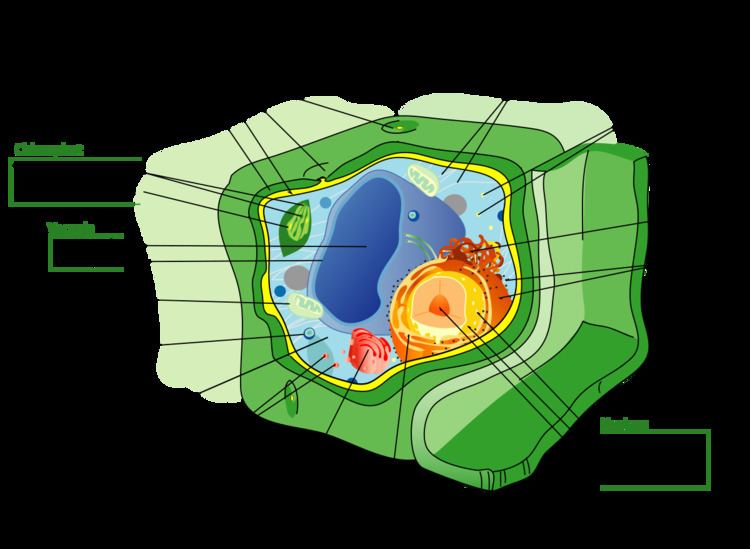 | ||
Plant cells are eukaryotic cells that differ in several key aspects from the cells of other eukaryotic organisms. Their distinctive features include:
Contents
Cell types
Pectin and hemicellulose are the dominant constituents of collenchyma cell walls of dicotyledon angiosperms, which may contain as little as 20% of cellulose in Petasites. Collenchyma cells are typically quite elongated, and may divide transversely to give a septate appearance. The role of this cell type is to support the plant in axes still growing in length, and to confer flexibility and tensile strength on tissues. The primary wall lacks lignin that would make it tough and rigid, so this cell type provides what could be called plastic support – support that can hold a young stem or petiole into the air, but in cells that can be stretched as the cells around them elongate. Stretchable support (without elastic snap-back) is a good way to describe what collenchyma does. Parts of the strings in celery are collenchyma.
Functions for sclereid cells (hard cells that give leaves or fruits a gritty texture) include discouraging herbivory, by damaging digestive passages in small insect larval stages, and physical protection (a solid tissue of hard sclereid cells form the pit wall in a peach and many other fruits). Functions of fibres include provision of load-bearing support and tensile strength to the leaves and stems of herbaceous plants. Sclerenchyma fibres are not involved in conduction, either of water and nutrients (as in the xylem) or of carbon compounds (as in the phloem), but it is likely that they may have evolved as modifications of xylem and phloem initials in early land plants.
Tissue types
The major classes of cells differentiate from undifferentiated meristematic cells (analogous to the stem cells of animals) to form the tissue structures of roots, stems, leaves, flowers, and reproductive structures.
Xylem cells are elongated cells with lignified secondary thickening of the cell walls. Xylem cells are specialised for conduction of water, and first appeared in plants during their transition to land in the Silurian period more than 425 million years ago (see Cooksonia). The possession of xylem defines the vascular plants or Tracheophytes. Xylem tracheids are pointed, elongated xylem cells, the simplest of which have continuous primary cell walls and lignified secondary wall thickenings in the form of rings, hoops, or reticulate networks. More complex tracheids with valve-like perforations called bordered pits characterise the gymnosperms. The ferns and other pteridophytes and the gymnosperms have only xylem tracheids, while the angiosperms also have xylem vessels. Vessel members are hollow xylem cells without end walls that are aligned end-to-end so as to form long continuous tubes. The bryophytes lack true xylem cells, but their sporophytes have a water-conducting tissue known as the hydrome that is composed of elongated cells of simpler construction.
Phloem is a specialised tissue for food transport in higher plants. Phloem cells mainly transport sucrose along pressure gradients generated by osmosis. This phenomenon is called translocation. Phloem consists of two cell types, the sieve tubes and the intimately associated companion cells. The sieve tube elements lack nuclei and ribosomes, and their metabolism and functions are regulated by the adjacent nucleate companion cells. Sieve tubes are joined end-to-end with perforate end-plates between known as sieve plates, which allow transport of photosynthate between the sieve elements. The companion cells, connected to the sieve tubes via plasmodesmata, are responsible for loading the phloem with sugars. The bryophytes lack phloem, but moss sporophytes have a simpler tissue with analogous function known as the leptome.
Plant epidermal cells are specialised parenchyma cells covering the external surfaces of leaves, stems and roots. The epidermal cells of aerial organs arise from the superficial layer of cells known as the tunica (L1 and L2 layers) that covers the plant shoot apex, whereas the cortex and vascular tissues arise from innermost layer of the shoot apex known as the corpus (L3 layer). The epidermis of roots originates from the layer of cells immediately beneath the root cap.
The epidermis of all aerial organs, but not roots, is covered with a cuticle made of the polyester cutin and/or the hydrocarbon polymer cutan with a superficial layer of epicuticular waxes. The epidermal cells of the primary shoot are thought to be the only plant cells with the biochemical capacity to synthesize cutin. Several cell types may be present in the epidermis. Notable among these are the stomatal guard cells, glandular and clothing hairs or trichomes, and the root hairs of primary roots. In the shoot epidermis of most plants, only the guard cells have chloroplasts. Chloroplasts contain the green pigment chlorophyll which is needed for photosynthesis.
